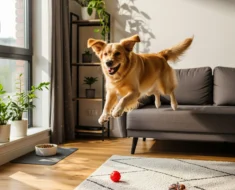Dogs communicate their feelings through body language and behavior. When your furry friend seems distant or upset, it is natural to wonder if something is wrong in your relationship. Many owners worry their pets might dislike them when they notice avoidance behaviors, selective listening, or a preference for other family members.
For comprehensive resources, visit the American Kennel Club (AKC). You can also find training videos on the AKC Official YouTube Channel or explore canine art and history at the AKC Museum of the Dog.
Learn more about your dog’s unique love language in this AKC guide. For additional insights, try the dog love language quiz on SpotOn Fence.
This quiz helps identify potential negative feelings in your dog and provides expert-backed strategies to rebuild trust and strengthen your connection. Using research from animal behaviorists, we will help you understand what your dog’s behaviors mean and how to address them effectively.
Take the Quiz: 15 Signs Your Dog Might Have Negative Feelings
Rate each behavior on its frequency (0-3):
- 0 = Never occurs
- 1 = Rarely occurs (once a month or less)
- 2 = Sometimes occurs (weekly)
- 3 = Frequently occurs (daily or multiple times per week)
| Sign | Description | Your Score (0-3) |
|---|---|---|
| 1. Avoids Eye Contact | Dog looks away when you try to make eye contact | |
| 2. Hides or Isolates | Retreats when you approach or enter the room | |
| 3. Shows Flattened Ears/Cowering | Displays anxious body language around you | |
| 4. Ignores Commands Selectively | Follows others’ commands but not yours | |
| 5. Refuses Treats from Your Hand | Will not take food from you but accepts from others | |
| 6. Won’t Share Toys | Does not bring toys to you or share possessions | |
| 7. Destroys Your Belongings | Targets your personal items for destruction | |
| 8. Eliminates on Your Belongings | Urinates/defecates specifically on your items | |
| 9. Shows Reactivity Around You | Growls, snaps, or shows aggression toward you | |
| 10. Prefers Other Family Members | Consistently chooses others over you | |
| 11. Shows Submissive Gestures | Displays calming signals in your presence | |
| 12. Seems Anxious Around You | Shows stress signals specifically with you | |
| 13. Moves Away When Approached | Creates distance when you try to interact | |
| 14. Reluctant During Handling | Resists grooming/care from you but not others | |
| 15. Lacks Enthusiasm With You | Shows reduced excitement for activities with you | |
| TOTAL SCORE: |
1. Avoids Eye Contact with You
Dogs typically make brief eye contact with people they trust. Consistent avoidance indicates discomfort or mistrust, as dogs view prolonged eye contact as threatening [1]. Rate how often your dog looks away when you try to make eye contact.
2. Hides or Isolates When You’re Around
A dog who retreats behind furniture, leaves the room when you enter, or stays distant specifically from you is showing clear avoidance. Rate how often your dog hides when you approach.
3. Shows Flattened Ears and Cowering Posture
When a dog flattens their ears against their head, lowers their body, and moves with slinking movements around you, they are expressing anxiety. Rate how frequently you observe these postures during your interactions.
4. Ignores Your Commands Selectively
Dogs who previously followed directions but now ignore commands from you while responding to others are communicating relationship issues. Rate your dog’s obedience level compared to their responses to other family members.
5. Refuses Treats from Your Hand
A dog that will not accept food from you but readily takes it from others is displaying a trust issue. Rate how often your dog refuses treats from you while accepting them from others.
6. Won’t Share Toys or Bring Items to You
Dogs naturally bring toys or prized possessions to humans they trust. Rate how your dog’s toy-sharing behavior with you compares to their behavior with others.
7. Destroys Your Personal Belongings
Targeted destruction of items carrying your scent (shoes, clothing) differs from general destructive behavior and can indicate relationship problems [2]. Rate how often your dog specifically targets your possessions.
8. Eliminates on Your Belongings
Inappropriate elimination specifically on your clothing or belongings is distinct from general house-training issues and may indicate targeted communication [2]. Rate incidents of elimination specifically on your items.
9. Shows Increased Reactivity Around You
Growling, snapping, or aggressive posturing directed specifically at you signals serious relationship concerns. Rate the frequency of reactive behaviors during your interactions.

10. Prefers Other Family Members Obviously
When a dog consistently greets others first, seeks affection from others, or chooses to sit with others instead of you, they are showing a preference. Rate the degree of preference shown to others over you.
11. Displays Submissive Appeasement Gestures
Head turning, lip licking, yawning, and avoiding your gaze are calming signals dogs use to de-escalate perceived tension [1]. Rate how often your dog shows these behaviors specifically in your presence.
12. Seems Anxious or Stressed Around You
Signs like excessive panting without exercise, whining, or shaking that occur specifically when you are present indicate stress. Rate how often these stress signals appear during your interactions.
13. Moves Away When You Approach
A dog that consistently creates distance when you try to interact or pet them is communicating discomfort. Rate how often your dog moves away when you initiate contact.
14. Shows Reluctance During Handling
Resistance to grooming, nail trimming, or medical care from you while accepting it from others suggests trust issues. Rate your dog’s handling acceptance with you versus others.
15. Lacks Enthusiasm for Activities with You
Reduced excitement for walks, playtime, or training with you compared to their general energy level signals relationship concerns. Rate your dog’s enthusiasm level for shared activities.
Quiz Scoring and Results
| Score Range | Relationship Status | Description |
|---|---|---|
| 0-10 points | Strong Bond | Your dog shows minimal concerning behaviors. Continue maintaining trust through positive reinforcement and quality time together. |
| 11-25 points | Relationship Needs Work | Some trust issues exist. Implement the expert tips below to improve your connection. |
| 26-45 points | Significant Relationship Issues | Your dog shows multiple signs of distress or negative associations with you. Consider consulting a professional dog behaviorist while implementing the strategies below. |
Important Note: These scores are a starting point, not a final diagnosis. Without specific scientific studies to confirm them, these categories are best used as general guides to help you identify areas for improvement in your relationship.
Understanding the Quiz Framework
The Science Behind C-BARQ
This quiz draws from principles established by the Canine Behavioral Assessment & Research Questionnaire (C-BARQ), developed by Yuying Hsu and James Serpell in 2003. C-BARQ is a standardized, owner-completed survey used for assessing behavioral problems and temperament traits in dogs.
Key Features of C-BARQ:
- Contains 100 items investigating 14 behavioral domains
- Assesses aggression types, fear/anxiety, trainability, excitability, and attachment
- Widely adopted in scientific research and diagnostic evaluations
- Available in multiple languages and used across different breeds
- Foundation for derivative assessments targeting similar behavioral dimensions
Medical and Environmental Causes to Consider
Before concluding your dog has negative feelings toward you, consider these alternative explanations for behavioral changes:
Physical Health Conditions
Pain and Discomfort:
- Arthritis, dental disease, or injuries causing irritability or withdrawal
- Joint and spinal issues leading to touch resistance
- General discomfort making dogs less social
Sensory Decline:
- Vision or hearing loss reducing responsiveness
- Increased startle reactions due to sensory impairment
- Fearfulness from inability to perceive the environment clearly
Neurological and Hormonal Issues:
- Seizures, brain tumors, or vestibular disease causing behavior changes
- Hypothyroidism, Addison’s disease, or Cushing’s syndrome affecting mood
- Diabetes leading to lethargy or irritability
Other Medical Concerns:
- Urinary or gastrointestinal problems causing inappropriate elimination
- Allergies and skin conditions increasing reactivity
- Systemic illness affecting energy and social behavior
Environmental Stressors
- Household changes (moving, new pets, schedule modifications)
- Environmental factors (loud noises, construction, unfamiliar surroundings)
- Generalized anxiety from various sources
- Cognitive dysfunction syndrome in senior dogs
Recommendation: Always consult a veterinarian to rule out medical causes before attributing behavioral changes to relationship issues.
Expert Tips to Rebuild Your Bond
Start with Basic Trust Building
- Establish consistent, predictable interactions.
- Approach your dog calmly from the side rather than head-on.
- Let your dog initiate contact when possible.
- Keep interactions positive and brief initially.
Use Positive Reinforcement Training
- Reward desired behaviors with treats, praise, or play.
- Time rewards immediately after good behavior.
- Avoid punishment-based techniques that damage trust.
- Focus on short, successful training sessions that build confidence.
Create Positive Associations
For Dogs That Hide When You Enter:
- Maintain a calm demeanor, avoiding loud noises or sudden movements.
- Establish a designated “safe zone” with a familiar blanket and toys.
- Gently toss high-value treats toward the hiding spot without forcing interaction.
- Quietly praise and reward when the dog ventures out or approaches.
- Gradually increase proximity over multiple sessions, consistently rewarding calm or curious behavior.
Gradual Exposure for Nail Trimming Fears:
- Week 1: Handle paws regularly without tools, rewarding calmness with treats.
- Week 2: Allow the dog to see and sniff clippers, rewarding calm behavior.
- Week 3: Practice creating sounds (clicking clippers) while offering treats for relaxation.
- Week 4: Simulate holding the paw and touching clippers to the nail without trimming.
- Week 5: Trim only one nail per session, reward generously, then stop.
- Ongoing: Gradually increase the number of nails trimmed as comfort improves.
Improve Your Body Language
- Avoid direct staring, which dogs find threatening.
- Keep your posture relaxed and non-threatening.
- Turn slightly sideways when approaching.
- Speak in a calm, gentle voice.
- Watch for and respect your dog’s discomfort signals.
Establish Consistent Routines
- Feed at regular times.
- Maintain predictable walk and exercise schedules.
- Set regular training and play sessions.
- Create a structure that helps your dog feel secure.
Finding Professional Help
Certified Positive Reinforcement Trainers
Look for these reputable certifications:
Certification Council for Professional Dog Trainers (CCPDT):
- CPDT-KA (Certified Professional Dog Trainer – Knowledge Assessed)
- CPDT-KSA (Knowledge and Skills Assessed)
- CBCC-KA (Certified Behavior Consultant Canine)
International Association of Animal Behavior Consultants (IAABC):
- CDBC (Certified Dog Behavior Consultant)
Karen Pryor Academy (KPA):
- KPA CTP (Karen Pryor Academy Certified Training Partner)
Veterinary Behaviorists
American College of Veterinary Behaviorists (ACVB):
- DACVB (Diplomate of the American College of Veterinary Behaviorists)
- Only veterinarians with DACVB credentials have completed specialized medical and behavior training.
Verification Process
- Search official organization directories online.
- Verify active credential status on organization websites.
- Confirm proper abbreviations after the professional’s name.
- Check state directories for board-certified veterinary behaviorists.
Why These Signs Matter: The Science Behind Dog Emotions
Research demonstrates clear connections between owner behavior, training approaches, and dog emotional responses. Studies reveal that dogs with negative feelings toward owners show measurable physiological responses, including elevated cortisol levels and decreased heart rate variability during interactions [3].
Dogs who experience primarily negative interactions with specific people develop avoidance behaviors and stress responses that closely mirror those seen in humans with relationship anxiety [4][5].
Red Flags: When Professional Help Is Essential
Seek immediate professional help if your dog:
- Shows aggressive behavior that is escalating
- Demonstrates extreme fear responses (shaking, hiding for hours)
- Has started growling, snapping, or biting
- Shows signs of past trauma or abuse
- Has sudden behavioral changes that might indicate medical issues
- Exhibits concerning behaviors that have not improved after 2-3 weeks of implementing strategies
Building Long-Term Success
Maintaining improvements requires consistency. Continue positive reinforcement training throughout your dog’s life, regularly assess your relationship’s health, and prevent issues by maintaining consistent positive interactions.
Remember that your dog’s trust is earned through reliable, positive experiences over time. Each positive interaction builds your emotional bank account with your dog, creating a buffer for occasional mistakes or misunderstandings.
Final Thoughts
Most dog-owner relationship issues can be resolved with patience, proper techniques, and an understanding of canine behavior. Taking this quiz is the first step toward building a stronger, more trusting relationship with your dog. Dogs are social animals that want a connection with their people. With consistent effort and the right approach, you can transform your relationship into one of mutual trust and enjoyment.
Frequently Asked Questions
Can you tell if your dog doesn’t like you?
Yes, dogs communicate their feelings through body language and behavior. Signs like avoiding your presence, refusing treats from you, showing stress signals when you approach, and preferring other people’s company can indicate negative feelings [1][2].
What causes a dog to dislike a person?
Dogs may develop negative associations with people due to past negative experiences, harsh training methods, unpredictable behavior, loud voices, threatening body language, or inconsistent care. Sometimes medical issues causing pain can also create negative associations.
Why does my dog not seem to like me anymore?
Sudden changes could stem from recent negative experiences, changes in your behavior or routine, undiagnosed pain, changes in your scent, or developmental changes in adolescent dogs. Consider recent events and consult a veterinarian to rule out medical causes [2].
How do I test if my dog loves me?
Look for signs of positive attachment like seeking proximity to you, calm behavior in your presence, enthusiastic greetings, checking in with you during activities, relaxed body language around you, and recovery from stress when you comfort them.
For a fun related quiz on your relationship with your dog, try the Are You Obsessed With Your Dog? Quiz.
References:
[1] https://vcahospitals.com/know-your-pet/canine-communication—interpreting-dog-language
[2] https://k9basics.com/how-do-you-know-if-your-dog-doesnt-like-you/
[3] https://pmc.ncbi.nlm.nih.gov/articles/PMC10944520/
[4] https://www.nature.com/articles/s41598-023-41849-0
[5] https://www.dvm360.com/view/is-bad-behavior-in-dogs-linked-to-owner-personality





